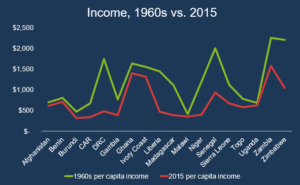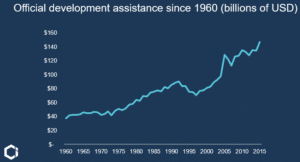Earlier I wrote a piece in the Guardian that discussed the development community’s obsession with ending poverty, and why that’s the biggest problem with the industry. The industry’s continuous focus on trying to end poverty limits its ability to develop and foster innovative solutions that are so desperately needed if poor countries are to achieve prosperity. This is a follow up piece that explains how the development industry has the equation for development—the one that has catapulted virtually every rich country today from poverty to prosperity—backwards.
Innovation, the ability to develop practical solutions to real problems, is the only thing that can create and sustain prosperity. Yet, in many development discourses, policies, and proposals, innovation is hardly mentioned. What is instead mentioned are things such as schools, hospitals, infrastructures, good governance, institutions, and several other indicators that are the benefits a society enjoys after being firmly rooted in a culture of innovation. What the development community misses is that it is impossible for poor countries to enjoy any of these benefits of development if they are not built on a foundation of innovation.
This miscalculation has resulted in the development industry spending hundreds of billions of dollars on official development assistance without much to show for it. Since 1960, the development community has spent more than four trillion dollars in official development assistance, and while some progress has been made—the rate of poverty is now less than ten percent—if we are to be honest with ourselves, China has been responsible for a large portion of the drop in global poverty. In fact, 18 countries, 17 of which are in Africa, have lower GDP per capitas than they did in the 1960s. So, what’s really going on here?
Innovation precedes development
In the mid-1800s, life expectancy in the United States was a mere 45 years and infant mortality stood at 176 deaths per 1,000 births. Average Americans spent 52% of their income on food and, in today’s dollars, the average person spent $54 per week on food, shelter, and clothing. More than 70% of America was also rural with fewer than 10% of the population attending secondary school.
To compound all this, corruption was also rife in America, as was nepotism—only 10% of civil service jobs resulted from unbiased recruitment, resulting in greater inequality between the privileged and average citizens. America’s poverty during that time rivals some of the poorest countries in the world today. And while these conditions were typical at the time, the main takeaway is that America lacked prosperity.
But instead of a strategy where America applied band-aids to problems by pushing the results of development—schools, hospitals, roads, railways, etc.—onto society, American entrepreneurs innovated. They created practical solutions that solvedmany of America’s problems, and these innovations fueled investments in other sectors.
For instance, many of America’s infrastructures got their start because entrepreneurs were trying to figure out better ways to solve transportation problems they had. The Baltimore and Ohio (B&O) Company, the first railroad in America, is an example. It was built in 1827 by a consortium of 25 American merchants and bankers – entrepreneurs, not government officials. The B&O railroad helped fuel commerce in the region and ensured that Baltimore remained competitive after the construction of the Erie Canal (built in 1820 to serve New York City).
The culture of innovation was pervasive in the 1800s. Isaac M. Singer, for instance, developed a sewing machine that drastically changed the lives of millions of people. Singer’s sewing machine reduced the amount of time it took for the average person (mostly women at the time) to sew a piece of clothing from one day to one hour. This meant that, instead of being tethered to a needle and thread for a whole day sewing one piece of clothing, women were now free to do more with their time. As a result, millions of Singer sewing machines were pulled into homes and factories. A clothing industry was born thereafter and Singer’s company became one of the first global enterprises in the world. When he died, his company had created tens of thousands of jobs and enabled millions. Singer left behind more than $300 million of wealth after he died. He did not go to school.
George Eastman, the father of photography and the founder of the Eastman Kodak company, was a high-school dropout and not considered particularly bright according to the standards of his era. But he figured out a way make photography simple and affordable, an innovation which had formerly been only available to the rich. In the 1890s, he created the Brownie camera which sold for one dollar ($27 in today’s dollars). Millions of Americans and people around the world pulled the camera into their lives. As a result, Eastman created more than 120,000 jobs and enabled thousands others. He once lived on less than one dollar a day.
These innovators are a small sampling of many of the innovators that had a significant impact on America during the 1800s and 1900s. We have not yet discussed Henry Ford, Andrew Carnegie, John D. Rockefeller, Amadeo Giannini, and several others. What these innovators had in common is that they transformed products that had historically been complex and expensive into products that were simple and affordable. We call these types of innovations market-creating innovations. As such, millions of people pulled these products into their lives. When that happened, they needed to create jobs…lots of jobs. As more Americans gained more income, schools, hospitals, and other benefits of these innovations became more viable, and thus prevalent in society.
A development strategy that does not have at its core meaningful job-creation is not a sustainable development strategy.
Implications for today
Today, many have the development equation backwards. Many in the industry, though not all—traditional development practitioners, emerging market investors and entrepreneurs, and policy makers—are working so hard to push the results (schools, hospitals, roads, etc.) of innovation and development onto poor countries in the hopes that they will develop. Unfortunately, the strategy will not work. It cannot because many of the solutions being pushed onto poor countries are neither practical nor do they solve the real problems that people in countries face.
In America, innovation preceded development. A culture of innovation was the foundation upon which development occurred. Development practitioners and policy makers would be wise to prioritize innovation—assessing the regions where they work and investing in practical solutions that solve real local problems. For without it, there can be no sustainable development.
For more, see:
Stop building schools; stop building water wells; stop building toilets





